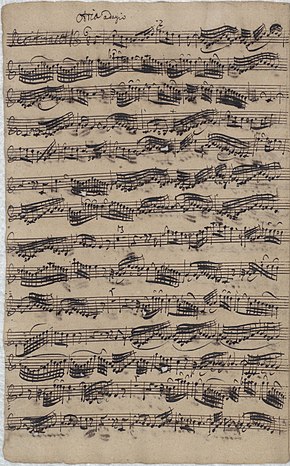
Back Wachet auf, ruft uns die Stimme, BWV 140 Afrikaans Wachet auf, ruft uns die Stimme, BWV 140 Catalan Wachet auf, ruft uns die Stimme, BWV 140 German Wachet auf, ruft uns die Stimme, BWV 140 Spanish Wachet auf, ruft uns die Stimme French Wachet auf, ruft uns die Stimme, BWV 140 Galician Wachet auf, ruft uns die Stimme רי"ב 140 HE Wachet auf, ruft uns die Stimme (Bach) Italian 目覚めよと、われらに呼ばわる物見らの声 Japanese Wachet auf, ruft uns die Stimme (BWV 140) Dutch
| Wachet auf, ruft uns die Stimme | |
|---|---|
BWV 140 | |
| Chorale cantata by J. S. Bach | |
 Autograph manuscript of the obbligato piccolo violino part of the first soprano-bass aria, one of the few surviving instrumental parts written by Bach, from the archives of the Thomaskirche | |
| Other name | Sleepers Awake |
| Occasion | 27th Sunday after Trinity |
| Chorale | "Wachet auf, ruft uns die Stimme" by Philipp Nicolai |
| Performed | 25 November 1731: Leipzig |
| Movements | 7 |
| Vocal |
|
| Instrumental |
|
Wachet auf, ruft uns die Stimme ('Awake, calls the voice to us'),[1] BWV 140, also known as Sleepers Awake, is a church cantata by Johann Sebastian Bach, regarded as one of his most mature and popular sacred cantatas. He composed the chorale cantata in Leipzig for the 27th Sunday after Trinity and first performed it on 25 November 1731.
Bach composed this cantata to complete his second annual cycle of chorale cantatas, begun in 1724. The cantata is based on the hymn in three stanzas "Wachet auf, ruft uns die Stimme" (1599) by Philipp Nicolai, which covers the prescribed reading for the Sunday, the parable of the Ten Virgins. The text and tune of the three stanzas of the hymn appears unchanged in three of seven movements (1, 4 and 7). An unknown author supplied additional poetry for the inner movements as sequences of recitative and duet, based on the love poetry of the Song of Songs. Bach structured the cantata in seven movements, setting the first stanza as a chorale fantasia, the second stanza in the central movement in the style of a chorale prelude, and the third stanza as a four-part chorale. He set the new texts as dramatic recitatives and love-duets, similar to contemporary opera. Bach scored the work for three vocal soloists (soprano, tenor and bass), a four-part choir and a Baroque instrumental ensemble consisting of a horn (to reinforce the soprano), two oboes, taille, violino piccolo, strings and basso continuo including bassoon.
Bach used the central movement of the cantata as the basis for the first of his Schübler Chorales, BWV 645. Bach scholar Alfred Dürr notes that the cantata is an expression of Christian mysticism in art, while William G. Whittaker calls it "a cantata without weaknesses, without a dull bar, technically, emotionally and spiritually of the highest order, its sheer perfection and its boundless imagination rouse one's wonder time and time again".[2][3]
- ^ Cite error: The named reference
Dellalwas invoked but never defined (see the help page). - ^ Whittaker, William Gillies (1978), The Cantatas of Johann Sebastian Bach: sacred and secular, Volume I, Oxford University Press, pp. 488–494, ISBN 019315238X
- ^ Cite error: The named reference
Gardinerwas invoked but never defined (see the help page).
© MMXXIII Rich X Search. We shall prevail. All rights reserved. Rich X Search